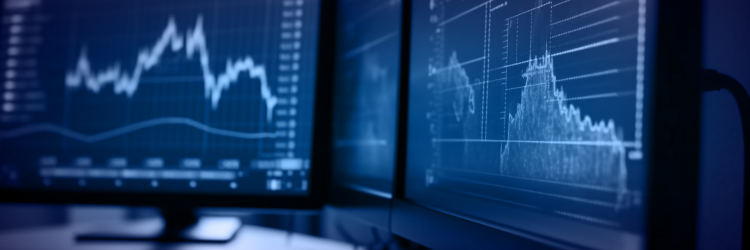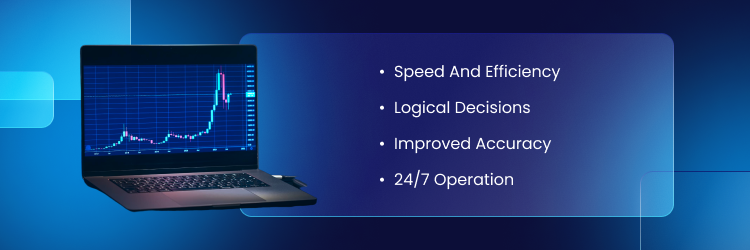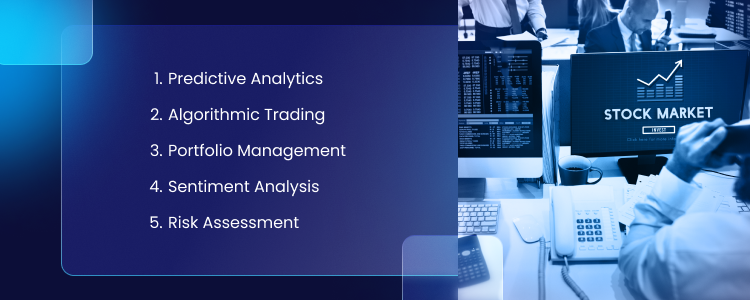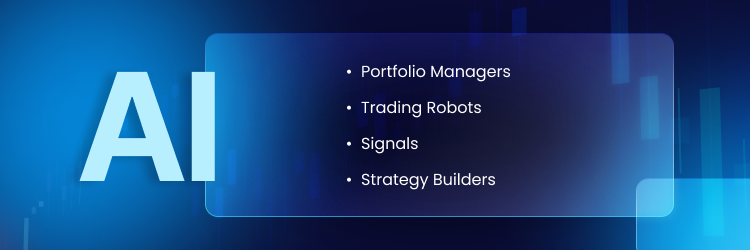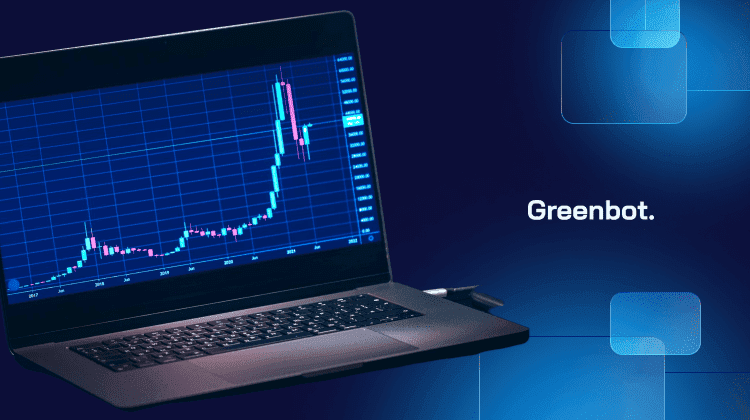
AI trading is transforming financial markets by making trades faster, more precise, and data-driven. It removes human bias, analyzes massive datasets in real-time, and reacts instantly to market shifts. Both independent and institutional traders use AI to refine strategies, optimize risk, and gain a competitive edge.
The market for AI trading is booming, expected to nearly double from $18 billion in 2023 to $35 billion by 2030. As AI systems continue to evolve, they are reshaping how traders make decisions, execute trades, and manage volatility.
In this guide, we’ll break down how AI trading works, its impact on stocks and crypto, and the tools traders can use to stay ahead in the market.
What Is AI Trading?
AI trading uses advanced algorithms to execute faster, more accurate trades, reducing the need for human intervention. These systems analyze market data, detect patterns, and execute trades in real-time. By minimizing human involvement, AI improves speed, accuracy, and efficiency.
Unlike traditional trading, AI reacts instantly to market shifts and removes emotional bias. It adapts to trends faster than human traders, making complex strategies more accessible.
AI trading has evolved from basic rule-based automation to self-learning algorithms. Modern AI adjusts to market conditions, helping traders seize opportunities, manage risk, and navigate volatility in stocks, forex, and crypto.
How Does AI Trading Work?
AI trading platforms transform market data into actionable insights, using algorithms to detect opportunities and manage risk. These systems scan market conditions in real time, identifying opportunities and executing trades precisely.
They follow three key steps:
- Identifying trades by analyzing price trends, sentiment, and market indicators.
- Assessing risk by evaluating volatility, liquidity, and trade sizing.
- Executing transactions instantly, often using high-frequency trading (HFT).
Unlike static strategies, machine learning enables AI to refine its approach based on past trades and market shifts. While automation enhances efficiency, human oversight remains vital to managing risks and adapting to unforeseen market events.
Benefits of AI in Trading
Here are four key advantages AI brings to trading:
- Speed and Efficiency: AI’s speed is crucial in high-frequency trading, where milliseconds matter. It detects price movements, identifies trends, and executes trades instantly. Human traders may take several seconds or minutes to react, giving AI a significant edge in high-frequency trading.
- Elimination of Human Emotion: Emotions like fear and greed often lead to impulsive decisions. AI removes this risk by following predefined strategies and statistical logic. Studies show that AI-assisted trades reduce human errors by 30%, leading to more consistent and disciplined trading outcomes.
- Enhanced Accuracy: AI analyzes multiple indicators, historical patterns, and external factors. In contrast to human traders, artificial intelligence can simultaneously process millions of data points. This improves trading decision-making and minimizes costly mistakes, helping traders execute high-probability trades.
- Continuous Market Monitoring: AI operates 24/7, constantly tracking market fluctuations and economic events. It reacts to sudden price changes instantly, ensuring no missed opportunities. This is especially useful for crypto and global markets, which never close.
Applications of AI in Stock Trading
Predictive Analytics
Predictive analytics helps traders anticipate stock price movements. It examines historical data, trends, and market conditions to detect early change signals. By identifying patterns, traders can adjust strategies before price shifts occur.
Many hedge funds rely on these models to refine investments. Renaissance Technologies, for example, analyzes market variables to gain an edge over traditional methods. Unlike human traders, these systems process multiple factors at once, spotting relationships that often go unnoticed.
Algorithmic Trading
Algorithmic trading automates transactions based on market conditions and predefined rules. It executes trades instantly and responds to rapid price movements.
Investment firms use these strategies to improve execution. Goldman Sachs and Citadel Securities rely on high-frequency trading (HFT) to process thousands of trades per second. This minimizes losses and captures short-term market inefficiencies.
Portfolio Management
Portfolio management helps investors maintain a balanced investment mix. It tracks market trends, risk exposure, and asset performance to optimize holdings.
Large firms like BlackRock use automated systems to adjust allocations. These tools reduce volatility and manage risk efficiently, ensuring portfolios align with market shifts without requiring constant manual oversight.
Sentiment Analysis
Stock prices are influenced by public perception and investor confidence. Sentiment analysis scans news, financial reports, and social media to gauge market mood.
Traders use this insight to act before sentiment-driven price changes. Hedge funds monitor Twitter, financial news, and earnings reports to detect early negativity. A decline in sentiment can trigger adjustments, helping traders avoid losses.
Risk Assessment
AI evaluates risks by simulating market scenarios and identifying vulnerabilities. It helps traders adjust strategies to minimize losses. For example, AI can anticipate adverse conditions like market crashes, allowing proactive risk management.
AI in Crypto Trading
Crypto trading operates 24/7, making manual trading difficult. Automated systems track price fluctuations, liquidity, and market activity to detect opportunities.
Arbitrage bots capitalize on price differences across exchanges. To assess investor behavior, sentiment tools monitor Telegram, Discord, and blockchain data. Portfolio managers rebalance holdings based on trends, adjusting for staking rewards and DeFi opportunities.
Security is critical. Automated fraud detection flags suspicious wallet movements, flash loan attacks, and rug pulls before they escalate. These systems help protect assets and effectively manage DeFi risks.
AI Trading Tools
Portfolio Managers
These tools track market conditions, asset performance, and risk levels. Platforms like Betterment and Wealthfront adjust allocations dynamically, reducing exposure while maximizing returns.
Trading Robots
Robotic systems execute trades based on market signals. In high-frequency and algorithmic trading, they react instantly to price movements, capturing short-term gains without human input.
Signals
Automated alerts analyze historical trends, sentiment, and technical indicators to highlight trade opportunities. Unlike static alerts, they adjust in real time to market shifts.
Strategy Builders
Traders test and refine strategies using simulated market conditions. Platforms like TradingView and MetaTrader allow backtesting, helping traders optimize before executing real trades.
Challenges and Limitations of AI Trading
- Data Dependency: AI models need large, accurate datasets to make good predictions. The system may misread market trends if the data is outdated or biased. Limited access to reliable data makes it harder for AI to adjust to sudden market changes, increasing the risk of bad trades.
- High Initial Costs: Developing an AI trading system is expensive. It requires software, hardware, and ongoing updates. Large firms can afford it, but smaller traders may struggle to keep up.
- Algorithm Bias: AI learns from historical data, but the system may reinforce bad patterns if the data is flawed. It can also fail to detect new trends. Traders who rely too much on AI risk making poor decisions in unpredictable markets.
- Regulatory Issues: Rules struggle to keep up with AI trading. Automated systems execute trades without direct oversight, raising concerns about fairness and manipulation. Without clear regulations, traders face legal risks.
AI Trading Use Cases
Data Mining for Opportunities
AI scans financial records, price trends, and trading volumes to detect patterns. It pulls insights from both structured sources, such as stock charts, and unstructured data, like news and social media. Early pattern detection gives traders an edge.
Sentiment Tracking
Market sentiment influences prices. AI analyzes news, reports, and social media to measure public mood. It prioritizes high-impact sources, helping traders separate short-term fluctuations from meaningful shifts.
Real-Time Monitoring
Markets move fast. AI tracks price changes, liquidity, and trading volumes in real-time. Instead of reacting after trends shift, AI spots movements early, allowing traders to adjust their positions instantly.
Predictive Modeling
AI studies historical trends, economic signals, and market volatility to forecast price movements. Unlike traditional indicators, AI models adapt to new market conditions, helping traders anticipate shifts instead of reacting to them.
Stress Testing
AI simulates extreme market events like crashes, liquidity shortages, and regulatory shifts. These tests help traders refine their risk strategies by giving them a deeper understanding of how their portfolios perform under pressure.
Backtesting Strategies
AI tests trading strategies using historical market data. It evaluates past conditions, news impacts, and execution speed, helping traders refine their methods before applying them in live markets.
Benchmarking Performance
AI compares performance against market standards, tracking key metrics like ROI and risk-adjusted returns. This helps traders identify weaknesses and optimize their strategies.
How to Start Using AI for Trading
1. Choose an AI Trading Platform
Choose a platform based on asset type, strategy, and costs. Some focus on stocks and forex, while others specialize in crypto automation. Compare execution speed and customization options.
2. Define Your Strategy
AI works best with clear rules. Traders should automate strategies like trend-following, arbitrage, or high-frequency trading while setting risk parameters.
3. Backtest the System
Run simulations to test strategy performance before using AI live. To refine trading models, backtesting tools analyze historical data, market conditions, and news impacts.
4. Monitor Performance
AI requires regular oversight. Use real-time dashboards to track win rates, risk exposure, and strategy performance. Set alerts to detect weaknesses early.
5. Stay Updated on Advancements
AI trading evolves constantly. Traders should follow blogs, webinars, and financial news to stay informed about new algorithms and regulatory changes.
Popular AI Stocks and AI ETFs
AI Stocks
Top companies in AI are leading advancements across industries. Nvidia powers AI with its Companies leading AI innovation include:
- Nvidia – Develops AI chips for automation and cloud computing.
- Taiwan Semiconductor (TSMC) – Produces semiconductors for AI hardware.
- ASML Holding – Specializes in chipmaking technology.
- Synopsys – Focuses on AI-powered chip design.
AI ETFs
AI-focused ETFs offer exposure to top AI companies:
- ROBO Global AI ETF (THNQ) – Covers AI software, hardware, and services.
- First Trust Nasdaq AI & Robotics ETF (ROBT) – Focuses on automation.
- Global X Robotics & AI ETF (BOTZ) – Invests in AI-powered robotics.
How to Trade AI Stocks and ETFs
Investing in AI stocks or ETFs requires a strategic approach. First, research AI-enhanced companies or ETFs to understand their focus areas. Next, select a trading platform that offers low-fee access to AI stocks and ETFs.
Finally, performance should be monitored regularly, and investments should be adjusted based on market trends. AI-powered trading tools can help analyze trends, automate trades, and improve decision-making for long-term gains.
Future of AI Trading
AI is getting smarter, faster, and more adaptive. In the future, trading models will create personalized strategies based on individual risk levels. Advanced computing will improve market predictions and real-time decision-making.
However, challenges remain. AI depends on high-quality data; poor inputs can lead to bad trades. Without clear regulations, AI could create unfair advantages or instability.
Despite these risks, AI trading will continue to evolve. New tools will refine strategies, increase automation, and make markets more efficient. Traders who balance AI insights with human judgment will gain an edge.
FAQs
Do AI trading bots work?
Yes, but their success depends on programming quality and data accuracy. To maintain performance, they need regular monitoring and updates.
Is AI trading legal?
Yes, as long as it follows financial regulations. However, some regions have specific rules for automated trading. Always check compliance before using AI for trades.
Are AI trading bots legit?
Many are, but scams exist. Choose reputable platforms with strong track records. Avoid services with unverified claims or unclear pricing.
Can AI trading guarantee profits?
No system guarantees profits. AI improves decision-making and efficiency, but market shifts require strategy adjustments and risk management.
How do I choose an AI trading platform?
Look for platforms with secure transactions, real-time data, and customizable strategies. Check user reviews and ensure the platform supports backtesting and risk controls.
What are the risks of AI trading?
AI depends on data quality and algorithm accuracy. Poor predictions, market volatility, or over-reliance on automation can cause losses. Traders should use stop-loss settings and review AI decisions regularly.
Final Thoughts
AI is changing the way traders approach financial markets. It boosts speed, accuracy, and strategy execution. However, human oversight remains critical for managing unexpected risks and ensuring responsible trading.
Transparency and fair regulations will shape AI’s role in finance. Developers must refine models to reduce bias, while regulators should prevent unfair advantages and market instability.
A balanced approach—combining automation with human judgment—will define the future of AI trading. Those who adapt wisely will stay ahead in evolving markets.


